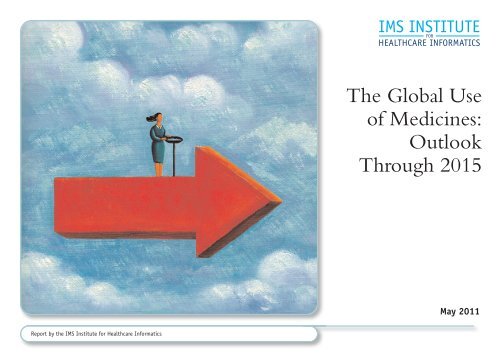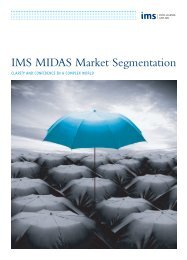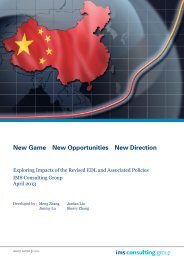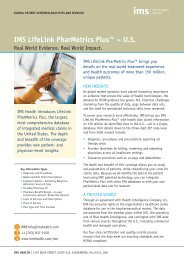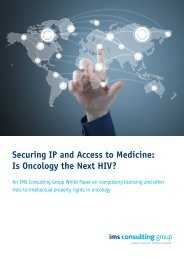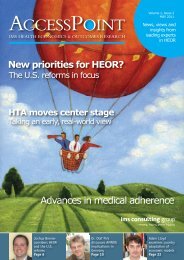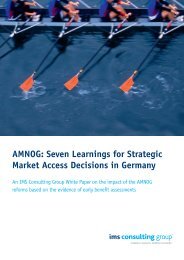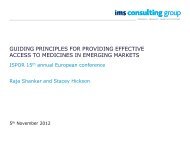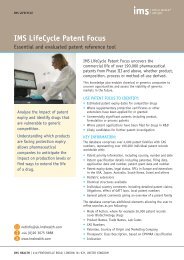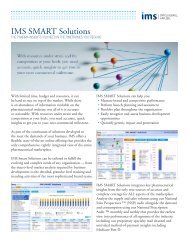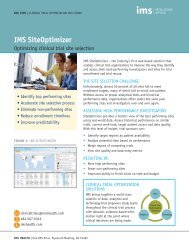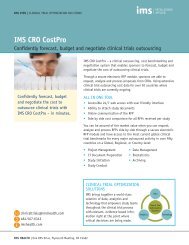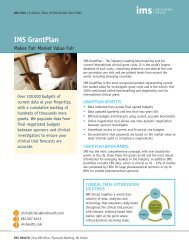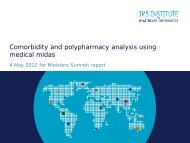The Global Use of Medicines - IMS Health
The Global Use of Medicines - IMS Health
The Global Use of Medicines - IMS Health
You also want an ePaper? Increase the reach of your titles
YUMPU automatically turns print PDFs into web optimized ePapers that Google loves.
<strong>The</strong> <strong>Global</strong> <strong>Use</strong><br />
<strong>of</strong> <strong>Medicines</strong>:<br />
Outlook<br />
Through 2015<br />
May 2011<br />
Report by the <strong>IMS</strong> Institute for <strong>Health</strong>care Informatics
Introduction<br />
<strong>The</strong> future level <strong>of</strong> global spending on medicines has implications for<br />
healthcare systems and policy makers across developed and emerging<br />
economies. Key decision makers share the common goals <strong>of</strong> improving health<br />
outcomes, while controlling costs and expanding access to more <strong>of</strong> their<br />
citizens. In this context, spending on biopharmaceuticals, <strong>of</strong>ten considered a<br />
driver <strong>of</strong> cost growth, represents an important opportunity to achieve increased<br />
access, cost reductions and better outcomes.<br />
Past spending growth <strong>of</strong>fers few clues to the level <strong>of</strong> growth to expect through<br />
2015. Unprecedented dynamics are at play – including historically high levels<br />
<strong>of</strong> patent expiry, rapid expansion <strong>of</strong> demand for medicines in the world’s fastest<br />
growing economies, fewer new medicines reaching patients, and more<br />
moderate uptake <strong>of</strong> those that do become available. <strong>The</strong>se dynamics are<br />
driving rapid shifts in the mix <strong>of</strong> spending between branded products and<br />
generics; and between spending in the major developed countries and those<br />
17 high growth emerging countries referred to as “pharmerging”.<br />
In this report we quantify the impact <strong>of</strong> these dynamics and examine the<br />
spending and usage <strong>of</strong> medicines in 2015, globally and for specific therapy<br />
areas and countries. We intend this report to provide a foundation for<br />
meaningful discussion about the value, cost and role <strong>of</strong> medicines over the<br />
next five years in the context <strong>of</strong> overall healthcare spending.<br />
Murray Aitken<br />
Executive Director<br />
<strong>IMS</strong> Institute for <strong>Health</strong>care Informatics<br />
<strong>IMS</strong> Institute for <strong>Health</strong>care Informatics<br />
11 Waterview Boulevard<br />
Parsippany, NJ 07054<br />
USA<br />
info@theimsinstitute.org<br />
www.theimsinstitute.org<br />
©2011 <strong>IMS</strong> <strong>Health</strong> Incorporated and its affiliates.<br />
All reproduction rights, quotations, broadcasting,<br />
publications reserved. No part <strong>of</strong> this publication may be<br />
reproduced or transmitted in any form or by any means,<br />
electronic or mechanical, including photocopy, recording,<br />
or any information storage and retrieval system, without<br />
express written consent <strong>of</strong> <strong>IMS</strong> <strong>Health</strong> and the <strong>IMS</strong><br />
Institute for <strong>Health</strong>care Informatics.<br />
FIND OUT MORE<br />
If you want to receive more reports from the<br />
<strong>IMS</strong> Institute, or be on our mailing list,<br />
please click here.<br />
<strong>The</strong> <strong>Global</strong> <strong>Use</strong> <strong>of</strong> <strong>Medicines</strong>: Outlook Through 2015<br />
Report by the <strong>IMS</strong> Institute for <strong>Health</strong>care Informatics<br />
1
Contents<br />
Executive summary................................................................3<br />
<strong>Global</strong> spending on medicines.....................................................4<br />
- Total spending and growth<br />
- Geographic distribution <strong>of</strong> spending<br />
- Product segment distribution <strong>of</strong> spending<br />
Key drivers <strong>of</strong> change ............................................................7<br />
- Brand growth<br />
- New therapies<br />
- Patent expiries<br />
- Changes in generic usage<br />
- Pharmerging markets<br />
Policy-driven changes and their impacts through 2015...........13<br />
- <strong>Health</strong>care system reforms<br />
- Biosimilars<br />
- Impact <strong>of</strong> changing rebate dynamics<br />
Key therapy areas................................................................16<br />
- Oncologics<br />
- Diabetes<br />
- Asthma/COPD<br />
- Lipid regulators<br />
- Angiotensin inhibitors<br />
Note on sources ..................................................................22<br />
Appendices.........................................................................23<br />
About the <strong>IMS</strong> Institute.......................................................27<br />
Key 2015 Numbers<br />
Spending $1.1 Trillion<br />
Patent “dividend” $98Bn<br />
Spending on generics $400-430Bn<br />
U.S. spending growth 0-3%<br />
China spending $115-125Bn<br />
Pharmerging spending share 28%<br />
Oncology spending $75-80Bn<br />
Off-invoice discounts and rebates $65-75Bn<br />
<strong>The</strong> <strong>Global</strong> <strong>Use</strong> <strong>of</strong> <strong>Medicines</strong>: Outlook Through 2015<br />
Report by the <strong>IMS</strong> Institute for <strong>Health</strong>care Informatics<br />
2
Executive summary<br />
SPENDING ON MEDICINES<br />
Spending on medicines will reach nearly $1,100Bn in<br />
2015, reflecting a slowing growth rate <strong>of</strong> 3-6% over the<br />
five year period compared to 6.2% annual growth over<br />
the past five years. Absolute global spending growth is<br />
expected to be $210-240Bn, compared to $251Bn since<br />
2005. <strong>The</strong> U.S. share <strong>of</strong> global spending will decline from<br />
41% in 2005 to 31% in 2015, while the share <strong>of</strong> spending<br />
from the top 5 European countries will decline from<br />
20% to 13% over the same period. Meanwhile, 17 high<br />
growth emerging markets led by China, will contribute<br />
28% <strong>of</strong> total spending by 2015, up from only 12% in<br />
2005. <strong>The</strong> next five years will also see an accelerating shift<br />
in spending toward generics, rising to 39% <strong>of</strong> spending in<br />
2015, up from 20% in 2005.<br />
KEY DRIVERS OF CHANGE<br />
In the major developed markets, spending on branded<br />
medicines will remain essentially unchanged in 2015<br />
from the level in 2010, since all increases in spending on<br />
brands will be <strong>of</strong>fset by reduced spending on those<br />
brands losing patent protection.<br />
Innovative products are expected to be launched which<br />
will bring important new treatment options to patients<br />
with cancer, diabetes, thrombosis and debilitating diseases<br />
<strong>of</strong> the central nervous system. Of particular note are the<br />
products for diabetes that are expected to bring new<br />
options to patients. Additional important new therapies<br />
with orphan drug designations or narrow indications<br />
are also expected, but will not be a major driver <strong>of</strong><br />
increased spending.<br />
All <strong>of</strong> the increase in spending on brands – both new and<br />
existing – will be <strong>of</strong>fset by patent expiries which will<br />
reduce brand spending by $120Bn through 2015. Only<br />
spending on generics will increase in developed markets<br />
over the next five years. In high growth emerging<br />
markets, spending will increase by $150Bn, as improved<br />
access and strengthening economies drive higher<br />
demand, primarily for generic drugs.<br />
POLICY-DRIVEN CHANGES AND IMPACTS THROUGH 2015<br />
Significant policy changes, made in 2010, will have<br />
longer-term impacts on the spending and usage <strong>of</strong><br />
medicines across many countries including the passage <strong>of</strong><br />
the Affordable Care Act in the U.S., a sweeping reform <strong>of</strong><br />
Japan’s unique every-other-year price-cut system, and<br />
several new reforms to rebalance spending priorities in<br />
each major European market. Important steps were also<br />
taken in the U.S. and Europe in the development <strong>of</strong><br />
scientific guidelines for the approval <strong>of</strong> biosimilars.<br />
In several markets rebates and discounts, which are not<br />
reflected in <strong>IMS</strong> audits, are increasingly being applied by<br />
public and private payers particularly in the U.S., France<br />
and Germany. <strong>The</strong> amount <strong>of</strong> these <strong>of</strong>f-invoice discounts<br />
in 2010 is estimated to be $60-65Bn, rising to $65-75Bn<br />
in 2015. If the discounts and rebates were fully reflected<br />
in our spending estimates, the five year increase would be<br />
$210-230Bn rather than the $210-240Bn referenced<br />
elsewhere in this report.<br />
KEY THERAPY AREAS<br />
Spending on most therapies will grow at slower rates – or<br />
even decline - through 2015. Specialty medicines will<br />
experience continued growth in the medium term<br />
driven by novel mechanisms, improved efficacy and<br />
relatively large patient populations, leading to increased<br />
uptake <strong>of</strong> these high-value medicines.<br />
<strong>Global</strong> oncology spending will reach $75Bn by 2015,<br />
rising at a much slower rate than in the past five years, as<br />
existing targeted therapies have already been widely<br />
adopted in most developed markets, some major products<br />
will be exposed to generic competition, and new<br />
products, with the potential to extend lives, will add<br />
treatment options in several major tumors, but will not<br />
contribute to significantly higher spending.<br />
<strong>Global</strong> spending on diabetes will increase by 4-7% over<br />
the next five years, accompanying increased prevalence <strong>of</strong><br />
Type 2 diabetes and treatment rates especially in<br />
countries such as China, India, Mexico and Brazil.<br />
Greater use <strong>of</strong> oral antidiabetic agents is expected due to<br />
their convenience and efficacy.<br />
Annual spending growth through 2015 will slow to 2-5%<br />
for asthma and COPD medicines compared to 9%<br />
growth over the past five years; spending on lipid<br />
regulators will fall to $31Bn in 2015 from $37Bn in<br />
2010; and patent expiries will limit angiotensin inhibitors<br />
growth to 1-4% over the next five years compared to<br />
12% over the prior five year period.<br />
<strong>The</strong> <strong>Global</strong> <strong>Use</strong> <strong>of</strong> <strong>Medicines</strong>: Outlook Through 2015<br />
Report by the <strong>IMS</strong> Institute for <strong>Health</strong>care Informatics<br />
3
GLOBAL SPENDING ON MEDICINES<br />
Spending on medicines will reach nearly $1,100Bn in 2015<br />
$605Bn<br />
<strong>Global</strong> Spending on <strong>Medicines</strong><br />
$251Bn<br />
$856Bn<br />
$210-<br />
240Bn<br />
$1,065-<br />
1,095Bn<br />
• Growth in the next five years will slow to<br />
3-6% CAGR compared to 6.2% over the<br />
past five years.<br />
• Spending on medicines globally is<br />
expected to exceed $1 trillion dollars in<br />
2014 and to reach nearly $1,100Bn<br />
by 2015.<br />
• Absolute growth is expected to be<br />
$210-240Bn compared to $251Bn in the<br />
prior five years.<br />
• Removing the effect <strong>of</strong> exchange rate<br />
fluctuations, growth will be $230-250Bn<br />
on a constant dollar basis, compared to<br />
$228Bn in the previous five years.<br />
2005 2006-10 2010 2011-15 2015<br />
Source: <strong>IMS</strong> Market Prognosis, Apr 2011<br />
Chart notes<br />
Spending in US$ with variable exchange rates.<br />
Compound annual growth rate (CAGR) in US$ using<br />
constant exchange rates.<br />
<strong>The</strong> <strong>Global</strong> <strong>Use</strong> <strong>of</strong> <strong>Medicines</strong>: Outlook Through 2015<br />
Report by the <strong>IMS</strong> Institute for <strong>Health</strong>care Informatics<br />
4
<strong>Global</strong> spending on medicines<br />
GLOBAL SPENDING ON MEDICINES<br />
U.S. and EU5 account for only 44% <strong>of</strong> spending in 2015<br />
U.S. and EU5 account for only 44% <strong>of</strong> spending in 2015<br />
$605Bn<br />
18%<br />
6%<br />
12%<br />
1%<br />
1%<br />
11%<br />
41%<br />
11%<br />
7%<br />
7%<br />
2%<br />
20%<br />
Spending<br />
Spending<br />
by<br />
by Geography<br />
Geography<br />
$856Bn<br />
7%<br />
36%<br />
3%<br />
17%<br />
2010<br />
$1,065-1,095Bn<br />
7%<br />
31%<br />
28%<br />
2%<br />
2%<br />
11%<br />
13%<br />
6%<br />
2015<br />
• <strong>The</strong> U.S. share <strong>of</strong> global spending will<br />
• <strong>The</strong> U.S. share <strong>of</strong> global spending will decline<br />
decline from 41% in 2005 to 31%, while<br />
from 41% in 2005 to 31%, while the EU5<br />
the EU5 share <strong>of</strong> spending will decline<br />
share <strong>of</strong> spending will decline from 20% to<br />
from 20% to 13% in 2015.<br />
13% in 2015.<br />
• Pharmerging markets, surpassing EU5 last<br />
• Pharmerging year, will reach markets, 28% <strong>of</strong> surpassing global spending EU5 in last<br />
year, 2015. will reach 28% <strong>of</strong> global spending in<br />
2015.<br />
• Share <strong>of</strong> global spending remains steady<br />
• Share for Japan, <strong>of</strong> global the rest spending <strong>of</strong> Europe remains and Canada. steady for<br />
Japan, the rest <strong>of</strong> Europe and Canada.<br />
2005<br />
US Canada EU5 Rest <strong>of</strong><br />
Europe<br />
Source: <strong>IMS</strong> Market Prognosis, Apr 2011<br />
Source: <strong>IMS</strong> Market Prognosis, Apr 2011<br />
<strong>The</strong> <strong>Global</strong> <strong>Use</strong> <strong>of</strong> <strong>Medicines</strong>: Outlook Through 2015<br />
Report <strong>The</strong> by the <strong>Global</strong> <strong>IMS</strong> Institute <strong>Use</strong> for <strong>of</strong> <strong>Health</strong>care <strong>Medicines</strong>: Informatics Outlook Through 2015<br />
Report by the <strong>IMS</strong> Institute for <strong>Health</strong>care Informatics<br />
Japan S. Korea Pharmerging ROW<br />
Chart notes<br />
Spending in US$ with variable exchange rates.<br />
Chart Notes:<br />
Spending in US$ with variable exchange rates.<br />
5<br />
0
<strong>Global</strong> spending on pharmaceuticals<br />
GLOBAL SPENDING ON MEDICINES<br />
An accelerated shift in spending on generics is expected<br />
An accelerated shift in spending on generics is expected<br />
$605Bn<br />
Spending<br />
Spending by<br />
by<br />
Segment<br />
Segment<br />
$1,065-1,095Bn<br />
$856Bn<br />
2015<br />
•!<br />
•!<br />
•!<br />
•!<br />
• Brands accounted for nearly two-thirds <strong>of</strong><br />
Brands accounted for nearly two-thirds <strong>of</strong><br />
global pharmaceutical spending in 2010<br />
global pharmaceutical spending in 2010 but<br />
but, as patents expire in developed<br />
as patents expire in developed markets that<br />
markets, that share is expected to decline.<br />
share is expected to decline.<br />
• Rapid growth in pharmerging markets is<br />
Rapid largely growth from spending Pharmerging on generic markets drugs is<br />
largely which from will spending contribute to on the generic rise in drugs the whic<br />
contribute generic share to the <strong>of</strong> spending. rise the generic share <strong>of</strong><br />
spending.<br />
• <strong>Global</strong> generic drug spending is estimated<br />
<strong>Global</strong> to be generic $234Bn drug in 2010, spending up from is $124Bn estimated to<br />
be $234Bn in 2005. in 2010, up from $124Bn in 2005<br />
Generics • Generics spending in in 2015 is is expected to to be<br />
between between $400-430Bn, $400-430Bn, 70% 70% <strong>of</strong> <strong>of</strong> which will be<br />
outside will be developed outside developed markets. markets.<br />
2005<br />
2010<br />
Source:<br />
Source:<br />
<strong>IMS</strong> Market<br />
<strong>IMS</strong><br />
Prognosis,<br />
Market<br />
Apr<br />
Prognosis,<br />
2011<br />
Apr 2011<br />
<strong>The</strong> <strong>Global</strong> <strong>Use</strong> <strong>of</strong> <strong>Medicines</strong>: Outlook Through 2015<br />
Report <strong>The</strong> by the <strong>Global</strong> <strong>IMS</strong> Institute <strong>Use</strong> for <strong>of</strong> <strong>Health</strong>care <strong>Medicines</strong>: Informatics Outlook Through 2015<br />
Report by the <strong>IMS</strong> Institute for <strong>Health</strong>care Informatics<br />
Chart notes<br />
Spending in US$ with variable exchange rates.<br />
Brand, Generic and Other segments defined by <strong>IMS</strong>’s<br />
Chart Notes: proprietary market segmentation methodology which<br />
Spending covers in US$ 31 leading with variable pharmaceutical exchange markets rates. globally.<br />
Brand, Estimated Generic and global Other generic segments spending defined includes by estimates <strong>IMS</strong>’s <strong>of</strong> proprietary<br />
Market unaudited Segmentation markets methodology, and market segments. which covers Estimates 31 <strong>of</strong>leading<br />
pharmaceutical Brand and markets Generic segments globally. in Estimated other markets global based generic on <strong>IMS</strong><br />
spending<br />
Institute<br />
includes<br />
for <strong>Health</strong>care<br />
estimates<br />
Informatics<br />
<strong>of</strong> unaudited<br />
research.<br />
markets<br />
Brands<br />
and market<br />
segments.<br />
include<br />
Estimates<br />
<strong>of</strong>f-patent<br />
<strong>of</strong><br />
brands.<br />
Brand<br />
Generics<br />
and Generic<br />
include<br />
segments<br />
branded<br />
in other<br />
markets based on <strong>IMS</strong> Institute for <strong>Health</strong>care Informatics<br />
generics. Other includes OTC and non-categorized products.<br />
research. Brands include <strong>of</strong>f-patent brands. Generics include<br />
branded generics. Other includes OTC and non-categorized<br />
products.<br />
6<br />
6
KEY DRIVERS OF CHANGE<br />
Pharmerging markets and generics are the only drivers <strong>of</strong> growth<br />
$856Bn<br />
Components <strong>of</strong> Change in Total Spending<br />
119 -120<br />
47<br />
150<br />
29<br />
$1,065<br />
-1,095Bn<br />
• <strong>The</strong> largest segment <strong>of</strong> growth in the<br />
next five years will be pharmerging<br />
markets, driven by increased access<br />
through reforms and economic growth.<br />
• Generic spending will increase by $47Bn,<br />
approximately 60% from increased<br />
utilization <strong>of</strong> existing generic products<br />
and 40% from newly available generics.<br />
• Despite the largest period <strong>of</strong> patent expiry<br />
in history, brands will <strong>of</strong>fset expiries with<br />
organic growth and new products.<br />
• <strong>The</strong> rest <strong>of</strong> the world will make a small<br />
contribution to increased spending, but<br />
masks a disparate and volatile expansion<br />
<strong>of</strong> health spending globally.<br />
2010 Brand LOE Generic<br />
Developed markets<br />
Pharmerging Other*<br />
2015<br />
*Other includes Rest <strong>of</strong> World +$27Bn, Other developed market growth +$17Bn, Exchange rate change -$15Bn<br />
Source: <strong>IMS</strong> Market Prognosis, Apr 2011<br />
Chart notes<br />
Spending in US$ with variable exchange rates.<br />
Developed countries are US, Japan, Germany, France, Italy,<br />
Spain, Canada, United Kingdom and South Korea.<br />
Brand (including vaccines), Generic and Loss <strong>of</strong> Exclusivity<br />
(LOE) are defined using <strong>IMS</strong> MIDAS market segmentation<br />
methodology.<br />
Other developed market growth includes OTC and<br />
non-categorized products.<br />
<strong>The</strong> <strong>Global</strong> <strong>Use</strong> <strong>of</strong> <strong>Medicines</strong>: Outlook Through 2015<br />
Report by the <strong>IMS</strong> Institute for <strong>Health</strong>care Informatics<br />
7
Key drivers <strong>of</strong> change<br />
KEY DRIVERS OF CHANGE<br />
<strong>The</strong> impact <strong>of</strong> patent expiries will <strong>of</strong>fset growth in brand spending<br />
<strong>The</strong> impact <strong>of</strong> patent expiries will <strong>of</strong>fset growth in brand spending<br />
$139Bn<br />
Components <strong>of</strong> Change in in Brand Brand Spending Spending<br />
Brand Growth<br />
$69Bn<br />
$119Bn<br />
Brand Growth<br />
-$1Bn<br />
• Spending • for branded products will will be be near<br />
the nearly same the in same 2015 in 2015 as in as 2010. in 2010.<br />
• Protected • brands will grow at at 7-8%, 7-8%,<br />
approximately 3-4% <strong>of</strong> <strong>of</strong> which which will will come come from<br />
price from growth, price growth, mostly mostly from from the the US. U.S.<br />
• Population<br />
• Population<br />
and<br />
and<br />
aging<br />
aging trends<br />
trends<br />
will<br />
will<br />
add<br />
add<br />
1%<br />
1% to<br />
age to and age and drug-use drug-use adjusted adjusted spending. spending.<br />
• Volume growth for branded products,<br />
• Volume<br />
including<br />
growth<br />
expected<br />
for<br />
new<br />
branded<br />
launches,<br />
products,<br />
will be<br />
including expected new launches, will be<br />
much lower than in the past five as<br />
much generics lower are than increasingly the preferred past five toyears as<br />
generics existing are or new increasingly brands. preferred to existi<br />
or new brands.<br />
-$70Bn<br />
-$120Bn<br />
2006-10 2011-15<br />
Source: <strong>IMS</strong> Institute for <strong>Health</strong>care Informatics; Market Prognosis,<br />
Source: Apr <strong>IMS</strong> Institute 2011 for <strong>Health</strong>care Informatics; Market Prognosis, Apr 2011<br />
<strong>The</strong> <strong>Global</strong><br />
<strong>The</strong> <strong>Global</strong><br />
<strong>Use</strong> <strong>of</strong><br />
<strong>Use</strong><br />
<strong>Medicines</strong>:<br />
<strong>of</strong> <strong>Medicines</strong>:<br />
Outlook Through<br />
Outlook<br />
2015<br />
Through 2015<br />
Report by the <strong>IMS</strong> Institute for <strong>Health</strong>care Informatics<br />
Report by the <strong>IMS</strong> Institute for <strong>Health</strong>care Informatics<br />
Chart notes<br />
Spending growth in US$ with constant exchange rates.<br />
Protected brands from <strong>IMS</strong> MIDAS market segmentation<br />
methodology.<br />
Chart Notes:<br />
Loss <strong>of</strong> Exclusivity (LOE) impact is calculated as the loss <strong>of</strong><br />
Spending growth in US$ with constant exchange rates.<br />
Protected<br />
brand<br />
brands<br />
sales due<br />
from<br />
to the<br />
<strong>IMS</strong><br />
impact<br />
Market<br />
<strong>of</strong> expected<br />
segmentation<br />
generic entry.<br />
methodology.<br />
Loss <strong>of</strong> Population Exclusivity and aging (LOE) trends impact include is calculated population as growth the loss <strong>of</strong> bran<br />
sales estimates due to the from impact the Economist <strong>of</strong> expected Intelligence generic Unit entry. and agerelated<br />
and drug-usage aging trends adjustments include from population <strong>IMS</strong> Market Prognosis. growth estimate<br />
Population<br />
from the Economist Intelligence Unit and age-related drug-usag<br />
adjustments from <strong>IMS</strong> Market Prognosis.<br />
8<br />
8
KEY DRIVERS OF CHANGE<br />
Recent and future novel therapies address unmet patient needs<br />
Selected Product Launches 2009-2013<br />
Disease area Launched Upcoming<br />
Arrhythmia<br />
Autoimmune<br />
Diabetes<br />
Hepatitis C<br />
Lupus<br />
Brinavess (vernakalant)<br />
Multaq ® (dronedarone)<br />
Simponi ® (golimumab)<br />
Stelara (ustekinumab)<br />
Nesina ® (alogliptin, DPPIV)<br />
Onglyza (saxagliptin, DPPIV)<br />
Victoza ® (liraglutide, GLP-1)<br />
Benlysta ® (belimumab)<br />
Source: <strong>IMS</strong> Institute for <strong>Health</strong>care Informatics, Apr 2011<br />
t<strong>of</strong>acitinib (JAK inhibitor)<br />
Melanoma Yervoy (ipilimumab) vemurafenib<br />
Multiple sclerosis<br />
Osteoporosis<br />
Thrombosis/<br />
Acute coronary<br />
syndrome<br />
Prostate cancer<br />
Ampyra ® (fampiridine, oral)<br />
Gilenya ® (fingolimod, oral)<br />
Prolia ® (denosumab)<br />
Brilique (ticagrelor, P2T)<br />
Effient ® (prasugrel, Xa)<br />
Pradaxa ® (dabigatran etexilate, Xa)<br />
Firmagon ® (degarelix)<br />
Jevtana ® (cabazitaxel)<br />
Provenge ® (sipuleucel-T)<br />
Bydureon (exenatide, GLP-1)<br />
canagliflozin (SGLT2)<br />
dapagliflozin (SGLT2)<br />
lixisenatide (GLP-1)<br />
Tradjenta (linagliptin, DPPIV)<br />
Victrelis (boceprevir, NS3-4A PI)<br />
®<br />
Incivek (telaprevir, NS3-4A PI)<br />
laquinimod (oral)<br />
ocrelizumab<br />
teriflunomide (oral)<br />
Eliquis<br />
®<br />
(apixaban, Xa)<br />
Zytiga (abiraterone acetate)<br />
• 30 innovative products, expected to be<br />
launched between 2009 and 2013, will drive<br />
growth between 2010 and 2015 as they<br />
become available around the world.<br />
• <strong>The</strong>se developments reflect new mechanisms <strong>of</strong><br />
action or delivery in major disease areas,<br />
bringing new therapeutic options to patients<br />
for whom available treatments are ineffective or<br />
whose side-effects make them inappropriate.<br />
• Of particular note are the large number <strong>of</strong><br />
products for diabetes with different<br />
mechanisms <strong>of</strong> action that are expected to<br />
bring new options to patients including the<br />
new SGLT2 class <strong>of</strong> drugs.<br />
• Additional important new therapies with<br />
orphan drug designations or narrow<br />
indications are expected, but will not be a<br />
major driver <strong>of</strong> increased spending.<br />
Chart notes<br />
Table includes selected recently launched New Active Substances<br />
(NAS) and late-stage pipeline. A NAS is the first commercial<br />
launch <strong>of</strong> a novel therapeutic entity. Products with orphan<br />
designated indications are not shown. Abbreviations: DPP-IV:<br />
dipeptidyl peptidase (DPP)-IV inhibitor; Xa: Xa coagulation<br />
factor inhibitor; SGLT: sodium-glucose cotransporter-2 (SGLT2)<br />
inhibitor; GLP-1: glucagon-like peptide-1 (GLP-1); P2T: platelet<br />
purinoceptor 2T; JAK: janus-like kinase inhibitor.<br />
Prolia (denosumab) is the first monoclonal antibody for<br />
osteoporosis and is also marketed as Xgeva for bone metastases.<br />
<strong>The</strong> <strong>Global</strong> <strong>Use</strong> <strong>of</strong> <strong>Medicines</strong>: Outlook Through 2015<br />
Report by the <strong>IMS</strong> Institute for <strong>Health</strong>care Informatics<br />
9
Key drivers <strong>of</strong> change<br />
KEY DRIVERS OF CHANGE<br />
Patent expiries will reduce brand spending by $120Bn through 2015<br />
Patent expiries will reduce brand spending by $120Bn through 201<br />
Developed<br />
Developed Markets<br />
Markets<br />
Patent<br />
Patent<br />
Expiries<br />
Expiries<br />
$171Bn<br />
47<br />
31<br />
36 34<br />
23<br />
-14<br />
-18<br />
-26<br />
-26<br />
-35<br />
• Patent<br />
• Patent<br />
expiries<br />
expiries<br />
will<br />
will save<br />
save<br />
payers<br />
payers<br />
in<br />
in Develope<br />
markets<br />
developed<br />
$120Bn<br />
markets<br />
in<br />
$120Bn<br />
the next<br />
in the<br />
five<br />
next<br />
years, <strong>of</strong>fse<br />
five years, <strong>of</strong>fset by $22Bn <strong>of</strong> expected<br />
by $22Bn <strong>of</strong> expected generic spending for<br />
generic spending for these medicines,<br />
these medicines, resulting in a $98Bn paten<br />
resulting in a $98Bn patent “dividend” in<br />
“dividend” during this period.<br />
these years.<br />
• This • This compares to $70Bn in in 2006-10 2006-10 which<br />
was which <strong>of</strong>fset was by <strong>of</strong>fset $16Bn by $16Bn <strong>of</strong> incremental <strong>of</strong> incremental generic<br />
usage generic <strong>of</strong> those usage <strong>of</strong> expired those expired brands, brands, a net a saving<br />
<strong>of</strong> net $54Bn. savings <strong>of</strong> $54Bn.<br />
• Patents • are expected to to expire expire in one in one or or<br />
more more <strong>of</strong> <strong>of</strong> the developed markets for for 11 <strong>of</strong> 11 <strong>of</strong> the<br />
top the 20, top or 20, 6 or <strong>of</strong> 6 the <strong>of</strong> the top top 10, 10, current leading<br />
medicines leading medicines including including Lipitor ® Lipitor , Plavix ® , ® ,<br />
Advair Plavix ® ® Diskus , Advair ® , Diskus Nexium ® , Nexium ® and ® Seroquel and ® .<br />
Seroquel ® .<br />
2011 2012 2013 2014 2015<br />
Pre-Expiry Spending<br />
-$120Bn<br />
Lower Brand Spending<br />
Source: Source: <strong>IMS</strong> Institute <strong>IMS</strong> for Institute <strong>Health</strong>care Informatics; <strong>Health</strong>care MIDAS, Dec Informatics; 2010 MIDAS, Dec 2010<br />
<strong>The</strong> <strong>Global</strong> <strong>Use</strong> <strong>of</strong> <strong>Medicines</strong>: Outlook Through 2015<br />
Report <strong>The</strong> by the <strong>Global</strong> <strong>IMS</strong> Institute <strong>Use</strong> for <strong>of</strong> <strong>Health</strong>care <strong>Medicines</strong>: InformaticsOutlook Through 2015<br />
Report by the <strong>IMS</strong> Institute for <strong>Health</strong>care Informatics<br />
Chart notes<br />
Spending expressed in US$ at constant exchange rates.<br />
Chart covers developed markets.<br />
Chart Lower Notes: brand spending reflects the expected impact in that<br />
Spending year expressed on drug spending US$ <strong>of</strong> patent constant expiries exchange (includingrates.<br />
Chart continuing covers developed impact from markets. expiries in prior years).<br />
Lower<br />
Pre-expiry<br />
brand spending<br />
spending<br />
reflects<br />
are the projected<br />
the expected<br />
sales in<br />
impact<br />
the year<br />
in that year o<br />
drug spending <strong>of</strong> patent expiries (including continuing impact fro<br />
prior to expiry.<br />
expiries in prior years).<br />
Pre-expiry spending are the projected sales in the year prior to<br />
expiry.<br />
10<br />
1
Key drivers <strong>of</strong> change<br />
KEY DRIVERS OF CHANGE<br />
Generics will exceed 20% <strong>of</strong> spending in most developed markets<br />
Generics will exceed 20% <strong>of</strong> spending in most developed markets<br />
Canada<br />
France<br />
Germany<br />
Italy<br />
Japan<br />
S Korea<br />
Spain<br />
Developed Markets Generic Generic Share Share<br />
•!<br />
•!<br />
•!<br />
•!<br />
•!<br />
Increased • generic spending the in next the five next five<br />
years will be driven by by generic generic competition competition<br />
new in new molecules due to patent expiry.<br />
Additional • Additional generic generic share share gains gains will will come come fro<br />
increased from increased incentives incentives for for the the usage usage <strong>of</strong> <strong>of</strong> gener<br />
in generics many markets. in many markets.<br />
• <strong>The</strong> U.S. will see the largest expansion <strong>of</strong><br />
<strong>The</strong> U.S. will see the largest expansion <strong>of</strong><br />
generics market spending, but the 7-8%<br />
generics market spending, but the 7-8% ga<br />
gain will largely be from new generics as<br />
will largely be from new generics as U.S.<br />
U.S. pharmacists already dispense<br />
pharmacists already dispense generics, whe<br />
generics, when available, 93% <strong>of</strong> the time.<br />
available, 93% <strong>of</strong> the time.<br />
• Japan will remain the developed market<br />
Japan with the will lowest remain generic the developed share despitemarket wit<br />
the significant lowest policy generic incentives share despite to increase significant<br />
policy generic incentives prescribing to and increase dispensing. generic<br />
prescribing and dispensing.<br />
• South Korea, with its well-developed<br />
South domestic Korea, industry, with will its continue well-developed to spend<br />
domestic the most on industry, generics will as a share continue <strong>of</strong> spending. to spend th<br />
most on generics as a share <strong>of</strong> spending.<br />
UK<br />
US<br />
Source: Source: <strong>IMS</strong> Market <strong>IMS</strong> Prognosis, Market Apr 2011 Prognosis, Apr 2011<br />
<strong>The</strong> <strong>Global</strong> <strong>Use</strong> <strong>of</strong> <strong>Medicines</strong>: Outlook Through 2015<br />
Report <strong>The</strong> by the <strong>Global</strong> <strong>IMS</strong> Institute <strong>Use</strong> for <strong>Health</strong>care <strong>of</strong> <strong>Medicines</strong>: InformaticsOutlook Through 2015<br />
Report by the <strong>IMS</strong> Institute for <strong>Health</strong>care Informatics<br />
Chart notes<br />
Spending share in US$ with variable exchange rates.<br />
Generic share <strong>of</strong> total pharmaceutical spending is<br />
Chart calculated notes: using <strong>IMS</strong> MIDAS market segmentation<br />
Spending methodology. share in Generic US$ with segment variable includes exchange branded generics rates.<br />
Generic and share excludes <strong>of</strong> OTC total medicines. pharmaceutical spending is calculated usi<br />
<strong>IMS</strong> proprietary Market Segmentation methodology. Generic<br />
segment includes branded generics and excludes OTC medicines<br />
11<br />
1
KEY DRIVERS OF CHANGE<br />
In pharmerging markets growth is mostly from generic drugs<br />
In pharmerging markets growth is mostly from generic drugs<br />
2010<br />
2010<br />
Growth<br />
to<br />
Growth<br />
2015<br />
to 2015<br />
Source: <strong>IMS</strong> Market Prognosis, Apr 2011<br />
Pharmerging Spending and Growth<br />
Pharmerging Spending and Growth<br />
China Brazil India Russia<br />
China Brazil India Russia<br />
41.1<br />
41.1<br />
6.7<br />
6.7<br />
62.6<br />
62.6<br />
10.2<br />
10.2<br />
22.9<br />
22.9<br />
16.8<br />
1.6<br />
12.3<br />
6.5 2.8<br />
13.4 11.0<br />
3.0<br />
Source: <strong>IMS</strong> Market Prognosis, Apr 2011<br />
12.3<br />
6.5 2.8<br />
16.8<br />
1.6<br />
13.6<br />
4.8<br />
13.4 11.0<br />
3.0<br />
3.9<br />
13.6<br />
4.8<br />
3.9<br />
Tier 3<br />
Pharmerging<br />
Tier 3<br />
Pharmerging<br />
60.6<br />
25.1<br />
45.7<br />
14.0<br />
60.6<br />
25.1<br />
45.7<br />
14.0<br />
Total spending<br />
Total Brand spending<br />
Brand spending<br />
•! Pharmerging countries are expected to ne<br />
• double Pharmerging pharmaceutical countries are spending expected toin the nex<br />
five nearly years, double adding pharmaceutical $150Bn spending, over that period<br />
adding $150Bn by 2015. Of the total<br />
•! Of the total increase in spending,<br />
increase in spending, approximately 20%<br />
approximately 20% will come from brande<br />
will come from branded products.<br />
products.<br />
• Many <strong>of</strong> the pharmerging countries have<br />
•! Many strong <strong>of</strong> domestic the Pharmerging companies which countries markethave<br />
strong low cost domestic generics, branded companies generics, which andmarket<br />
cost in some generics, cases, unauthorized branded generics, copies <strong>of</strong> and in so<br />
cases, original unauthorized brands. copies <strong>of</strong> original bran<br />
•! • Political pressure to to provide provide greater greater access access<br />
healthcare to is is driving significant governmen<br />
government-supported expansion expansion <strong>of</strong> access <strong>of</strong>to medicine<br />
across access to these medicines countries. across these countries.<br />
•! • Patients pay pay for for the the majority majority <strong>of</strong> medicines <strong>of</strong> medicines<br />
out-<strong>of</strong>-pocket in in these these markets, markets, with with a a few<br />
exceptions, few exceptions, which which limits limits the the usage <strong>of</strong> <strong>of</strong><br />
expensive newer newer medicines. medicines.<br />
Chart notes<br />
Spending share in US$ with variable exchange rates.<br />
Chart Notes:<br />
Spending Growth share in US$ in at US$ constant with exchange variable rates. exchange rates.<br />
Growth Gross in Domestic US$ at Product constant (GDP) exchange from the rates. Economist<br />
Gross Intelligence Domestic Unit. Product (GDP) from the Economist Intelligence<br />
Unit.<br />
Brands include vaccines, but exclude branded generics,<br />
Brands include vaccines using <strong>IMS</strong>’s proprietary market<br />
using <strong>IMS</strong> MIDAS market segmentation methodology.<br />
segmentation methodology.<br />
<strong>The</strong> <strong>Global</strong> <strong>Use</strong> <strong>of</strong> <strong>Medicines</strong>: Outlook Through 2015<br />
<strong>The</strong> <strong>Global</strong> Report <strong>Use</strong> by <strong>of</strong> the <strong>Medicines</strong>: <strong>IMS</strong> Institute Outlook for Through <strong>Health</strong>care 2015 Informatics<br />
Report by the <strong>IMS</strong> Institute for <strong>Health</strong>care Informatics<br />
12<br />
1
POLICY-DRIVEN CHANGES AND THEIR IMPACTS THROUGH 2015<br />
Significant policy changes in 2010 will have longer-term impacts<br />
Impact <strong>of</strong> Policy Changes on Cost & Access<br />
• <strong>The</strong> U.S. passed the Affordable Care Act<br />
which expands health insurance coverage<br />
to 25-30Mn uninsured Americans and is<br />
intended to address health system costs,<br />
quality and access.<br />
• Japan implemented its first price cut<br />
under its new protected innovative<br />
products policy, initiating a change in<br />
balance between innovation and the use<br />
<strong>of</strong> <strong>of</strong>f-patent products.<br />
• Spain and Italy made substantial<br />
reductions to generic and <strong>of</strong>f-patent<br />
brand prices to encourage higher generic<br />
utilization and lower health system costs.<br />
• Germany implemented mandatory<br />
cost-benefit evaluations <strong>of</strong> new medicines<br />
after their first year on the market,<br />
potentially restricting pricing and<br />
reimbursement.<br />
• China applied widespread price cuts to<br />
ensure the sustainability <strong>of</strong> universal<br />
healthcare coverage.<br />
Source: <strong>IMS</strong> Institute for <strong>Health</strong>care Informatics, Apr 2011<br />
<strong>The</strong> <strong>Global</strong> <strong>Use</strong> <strong>of</strong> <strong>Medicines</strong>: Outlook Through 2015<br />
Report by the <strong>IMS</strong> Institute for <strong>Health</strong>care Informatics<br />
13
POLICY-DRIVEN CHANGES AND THEIR IMPACTS THROUGH 2015<br />
Biosimilars are emerging rapidly but adoption to date is limited<br />
$138Bn<br />
2006-<br />
2010<br />
CAGR<br />
11.7%<br />
<strong>Global</strong> Biologics Spending<br />
2010 2015<br />
Biosimilars<br />
$2-2.5Bn<br />
Biosimilars $190 –<br />
11%<br />
$311Mn 200Bn<br />
5%<br />
33%<br />
25%<br />
42%<br />
2011-<br />
2015<br />
CAGR<br />
6-9%<br />
Source: <strong>IMS</strong> Institute for <strong>Health</strong>care Informatics; MIDAS Dec 2010<br />
70%<br />
epoeitin alfa<br />
somatropin<br />
filgrastim<br />
14%<br />
New Biosimilars<br />
<strong>Global</strong> Biosimilars<br />
Originator Biologics<br />
• <strong>Global</strong> biologic spending was $138Bn in<br />
2010, compared to $311Mn for biosimilars.<br />
• Much <strong>of</strong> the global biologics spending is<br />
concentrated in the U.S. Biosimilar spending<br />
is concentrated in Germany and other<br />
European markets which adopted approval<br />
guidelines earlier, and now account for over<br />
80% <strong>of</strong> global biosimilars spending.<br />
• Europe’s approval guidelines for monoclonal<br />
antibodies, expected later this year, will add<br />
new molecules to the competitive space<br />
through 2015.<br />
• <strong>The</strong> U.S. approval pathway, included in the<br />
Affordable Care Act, grants 12 years <strong>of</strong><br />
market exclusivity to originator biologics.<br />
New biosimilars are expected to enter the<br />
U.S. market by 2014, including epoeitin alfa<br />
and filgrastim, which currently have<br />
approved biosimilars only outside the U.S.<br />
Chart notes<br />
Spending in US$ with variable exchange rates.<br />
Biosimilar products are biologic products approved in a<br />
country which has an abbreviated approval process for<br />
biologic products that reference an originator biologic in<br />
the regulatory submission.<br />
Products marketed in countries without a biosimilar<br />
approval pathway and for which the originator has not<br />
granted a license are not considered biosimilars.<br />
.<br />
<strong>The</strong> <strong>Global</strong> <strong>Use</strong> <strong>of</strong> <strong>Medicines</strong>: Outlook Through 2015<br />
Report by the <strong>IMS</strong> Institute for <strong>Health</strong>care Informatics<br />
14
POLICY-DRIVEN CHANGES AND THEIR IMPACTS THROUGH 2015<br />
Increased rebates and discounts have $5-10Bn impact on growth<br />
Estimated Net Sales<br />
Net Sales Adjustment<br />
$856Bn<br />
$60-65Bn<br />
<strong>Global</strong> Spending to 2015<br />
$210-<br />
230Bn<br />
$5-10Bn<br />
2010 Growth Incremental<br />
Net Sales Adjustment<br />
Source: <strong>IMS</strong> Market Prognosis, Apr 2011<br />
$210-240Bn<br />
$1,065-<br />
1,095Bn<br />
$65-75Bn<br />
2015<br />
• <strong>IMS</strong> estimates <strong>of</strong> total spending are based<br />
on <strong>IMS</strong> audits which do not reflect <strong>of</strong>finvoice<br />
discounts and rebates in most<br />
markets.<br />
• <strong>The</strong> amount <strong>of</strong> <strong>of</strong>f-invoice discounts in<br />
2010 is estimated to be $60-65Bn, rising<br />
to $65-75Bn in 2015.<br />
• If the discounts and rebates were fully<br />
reflected in our spending estimates, the<br />
increase would be $210-230Bn as<br />
opposed to the $210-240Bn referenced<br />
elsewhere in this report.<br />
• Rebate increases driven by commercial<br />
considerations are the most significant, are<br />
generally paid for protected brands, and<br />
cease on patent expiry.<br />
• Public policy practices in the U.S., France<br />
and Germany are increasing mandatory<br />
rebates while other countries, including<br />
Italy and Canada, are banning rebates and<br />
implementing more transparent pricing<br />
systems.<br />
Chart notes<br />
Estimated Net Sales Adjustment is based on a comparison<br />
<strong>of</strong> company reported net sales and <strong>IMS</strong> reported sales at<br />
invoice prices from wholesaler transactions.<br />
<strong>The</strong> <strong>Global</strong> <strong>Use</strong> <strong>of</strong> <strong>Medicines</strong>: Outlook Through 2015<br />
Report by the <strong>IMS</strong> Institute for <strong>Health</strong>care Informatics<br />
15<br />
1
KEY THERAPY AREAS<br />
Spending growth on most therapies will be lower through 2015<br />
SPENDING CAGR 2006-2010<br />
20%<br />
15%<br />
10%<br />
5%<br />
0%<br />
Leading <strong>The</strong>rapy Classes in 2015<br />
2015 Spending<br />
Antipsychotics<br />
Antidepressants<br />
Anti-ulcerants<br />
50bn<br />
25bn<br />
5bn<br />
Specialty<br />
Traditional<br />
Antidiabetics<br />
Narcotic analgesics<br />
Asthma/COPD<br />
Glaucoma<br />
Lipid regulators<br />
ESA<br />
ADHD<br />
Alzheimer's<br />
Angiotensin<br />
inhibitors<br />
Antivirals excl. HIV<br />
Anti-epileptics<br />
Platelet agg<br />
inhibitors<br />
Autoimmune<br />
Multiple sclerosis<br />
Oncology<br />
HIV antivirals<br />
Osteoporosis<br />
-5%<br />
-10% -5% 0% 5% 10%<br />
SPENDING CAGR 2011-2015<br />
Source: <strong>IMS</strong> Institute for <strong>Health</strong>care Informatics; <strong>The</strong>rapy Forecaster, May 2011<br />
• Of the 20 largest therapy classes, spending<br />
in 7 will decline over the next five years<br />
with only anti-epileptics and osteoporosis<br />
growing faster than in the past five years.<br />
• Specialty medicines will experience<br />
continued growth in the medium term,<br />
driven by novel mechanisms, improved<br />
efficacy and relatively large patient<br />
populations leading to increased uptake <strong>of</strong><br />
these high-value medicines.<br />
• Growth is decelerating in most other<br />
therapy areas due to patent expiries and the<br />
lack <strong>of</strong> significant new treatment options.<br />
Chart notes<br />
All spending and growth in US$ with constant exchange<br />
rates. Bubble size reflects 2015 spending.<br />
Specialty therapies are comprised <strong>of</strong> products with a<br />
variety <strong>of</strong> characteristics including being injectable,<br />
high-cost, cold-chain distribution, patient follow-up or<br />
monitoring.<br />
<strong>The</strong>rapy forecasts for Oncology, Autoimmune, ADHD and<br />
Erythropoiesis stimulating agents (ESA) from the <strong>IMS</strong><br />
Institute for <strong>Health</strong>care Informatics. All other classes from<br />
<strong>IMS</strong> <strong>The</strong>rapy Forecaster.<br />
Abbreviations: ADHD-Attention Deficit Hyperactivity<br />
Disorder; HIV-Human Immunodeficiency Virus;<br />
COPD-Chronic Obstructive Pulmonary Disease.<br />
<strong>The</strong> <strong>Global</strong> <strong>Use</strong> <strong>of</strong> <strong>Medicines</strong>: Outlook Through 2015<br />
Report by the <strong>IMS</strong> Institute for <strong>Health</strong>care Informatics<br />
16
KEY THERAPY AREAS<br />
<strong>Global</strong> oncology spending will reach $75Bn by 2015<br />
CAGR<br />
2006-10<br />
13.2%<br />
$57.1<br />
Bn<br />
<strong>Global</strong> Oncology Growth to 2015<br />
• New mechanisms<br />
• Uptake <strong>of</strong> recent<br />
launches<br />
• Additional<br />
indications<br />
• Pharmerging<br />
• R&D successes<br />
• Fewer new patients<br />
• Patent expiries<br />
• Biosimilars<br />
• Cost containment<br />
Source: <strong>IMS</strong> Institute for <strong>Health</strong>care Informatics; <strong>The</strong>rapy Forecaster, May 2011<br />
CAGR<br />
2011-15<br />
5-8%<br />
$75-<br />
80Bn<br />
2010 2015<br />
• Existing targeted therapies have already<br />
been widely adopted in most developed<br />
markets, thereby limiting future new<br />
patients and spending growth.<br />
• Current oncology spending <strong>of</strong> $9.6Bn<br />
will be exposed to generic competition<br />
through 2015.<br />
• Cost-containment mechanisms are<br />
expected to expand, including higher<br />
co-payments in the U.S., HTA-based<br />
reimbursement restrictions in Europe, and<br />
the approval <strong>of</strong> biosimilars.<br />
• Growth in pharmerging markets will be<br />
lifted by traditional chemotherapy regimens.<br />
• New products with the potential to extend<br />
lives will add treatment options in several<br />
major tumors, but will not contribute to<br />
significantly higher spending.<br />
Chart notes<br />
All spending and growth in US$ with constant exchange<br />
rates. Oncology includes traditional chemotherapy and<br />
hormonal chemotherapy agents as well as targeted<br />
therapies. All sales for products whose primary indication<br />
is the treatment <strong>of</strong> cancers including for other uses are<br />
included. Supportive care therapies such as anti-nausea,<br />
colony stimulating factors (white blood cell boosters) and<br />
red blood cell boosters (ESA) are not included.<br />
<strong>The</strong> <strong>Global</strong> <strong>Use</strong> <strong>of</strong> <strong>Medicines</strong>: Outlook Through 2015<br />
Report by the <strong>IMS</strong> Institute for <strong>Health</strong>care Informatics<br />
17
KEY THERAPY AREAS<br />
<strong>Global</strong> spending on diabetes will increase by 4-7%<br />
CAGR<br />
2006-10<br />
11.9%<br />
$34.9<br />
Bn<br />
<strong>Global</strong> Diabetes Growth to 2015<br />
• Volume in<br />
pharmerging<br />
• Disease prevalence<br />
• GLP-1, DPP-IV,<br />
SGLT2<br />
• Efficacy and safety<br />
<strong>of</strong> new treatments<br />
• Continued<br />
problems with<br />
access and<br />
adherence<br />
• Step therapy keeps<br />
expensive newer<br />
therapies in<br />
reserve, making<br />
therapy affordable<br />
CAGR<br />
2011-15<br />
4-7%<br />
$43-<br />
48Bn<br />
• Growing patient populations, particularly<br />
in pharmerging countries such as China,<br />
India and Brazil, along with changing<br />
lifestyle conditions globally, will increase<br />
the prevalence <strong>of</strong> Type II diabetes.<br />
• Greater use <strong>of</strong> oral antidiabetic agents is<br />
expected due to their convenience and<br />
efficacy.<br />
• Complex administration and dosing <strong>of</strong><br />
insulin products affects compliance and<br />
adherence.<br />
• Recent FDA guidance on increased<br />
monitoring <strong>of</strong> cardiovascular and cancer<br />
risks has affected the use <strong>of</strong> marketed<br />
drugs and delayed new approvals by<br />
requiring additional clinical evidence.<br />
2010 2015<br />
Source: <strong>IMS</strong> Institute for <strong>Health</strong>care Informatics; <strong>The</strong>rapy Forecaster, May 2011<br />
Chart notes<br />
All spending and growth in US$ with constant<br />
exchange rates.<br />
DPP-IV Inhibitor: Dipeptidyl peptidase-4 inhibitor.<br />
GLP-1: Glucagon-like peptide-1.<br />
SGLT2: Sodium glucose co-transporter-2.<br />
<strong>The</strong> <strong>Global</strong> <strong>Use</strong> <strong>of</strong> <strong>Medicines</strong>: Outlook Through 2015<br />
Report by the <strong>IMS</strong> Institute for <strong>Health</strong>care Informatics<br />
18
KEY THERAPY AREAS<br />
Spending growth slows to 2-5% for asthma and COPD medicines<br />
CAGR<br />
2006-10<br />
9.4%<br />
$36.3<br />
Bn<br />
<strong>Global</strong> Asthma/COPD Growth to 2015<br />
• Chronic unmet<br />
medical need<br />
• New combinations<br />
• Difficult to make<br />
devices limits<br />
competition<br />
• Efficacy and<br />
safety <strong>of</strong> new<br />
classes<br />
• Safety guidelines<br />
on LABAs<br />
• Patent expiries<br />
• Success <strong>of</strong> generic<br />
device<br />
manufacturers<br />
Source: <strong>IMS</strong> Institute for <strong>Health</strong>care Informatics; <strong>The</strong>rapy Forecaster, May 2011<br />
CAGR<br />
2011-15<br />
2-5%<br />
$41-<br />
46Bn<br />
2010 2015<br />
• Long-term use driven by the chronic<br />
nature <strong>of</strong> the asthma and Chronic<br />
Obstructive Pulmonary Disease (COPD)<br />
will drive spending growth.<br />
• Patients and payers are willing to pay more<br />
for effective branded products due to the<br />
moderate efficacy <strong>of</strong> current options.<br />
• Inhaler delivery devices with separate<br />
patent protection will continue to<br />
minimize direct competition, despite<br />
ongoing efforts to develop generics with<br />
non-infringing devices.<br />
• Key products exposed to generic<br />
competition include Advair ® Diskus ® ,<br />
marketed internationally as Seretide ® , and<br />
Singulair ® which will lose active<br />
ingredient patent protection in the U.S.<br />
in 2011 and 2012 respectively, but are less<br />
likely to face direct competition due to<br />
their delivery devices.<br />
Chart notes<br />
All spending and growth in US$ with constant exchange<br />
rates. Asthma/COPD therapies in this analysis include drugs<br />
for Asthma and COPD, but does not include other inhaled<br />
or nasal medicines for allergies or allergic rhinitis.<br />
LABA: Long Acting Beta Agonists.<br />
<strong>The</strong> <strong>Global</strong> <strong>Use</strong> <strong>of</strong> <strong>Medicines</strong>: Outlook Through 2015<br />
Report by the <strong>IMS</strong> Institute for <strong>Health</strong>care Informatics<br />
19
KEY THERAPY AREAS<br />
Spending on lipid regulators will decline by 2-5%<br />
CAGR<br />
2006-10<br />
1.6%<br />
$37.0<br />
Bn<br />
<strong>Global</strong> Lipid Regulator Growth to 2015<br />
• Continuing<br />
volume demand<br />
enhanced by<br />
affordability<br />
• High disease<br />
prevalence<br />
• <strong>The</strong>rapeutic<br />
substitution<br />
• Patent expiries<br />
• New generation<br />
therapies have<br />
failed in R&D<br />
CAGR<br />
2011-15<br />
-2 to -5%<br />
$29-<br />
34Bn<br />
• <strong>Global</strong> lipid regulator spending will<br />
decline as key expiries are expected to<br />
impact the class across major markets.<br />
• Lipitor ® is expected to face generic<br />
competition in the U.S. in 2011.<br />
• Earlier expiries have already shifted a<br />
large number <strong>of</strong> patients to generics,<br />
including switching from a branded<br />
product to a generic <strong>of</strong> a different<br />
molecule to achieve cost savings.<br />
• Next-generation therapies in the class<br />
have generally failed to pass regulatory<br />
hurdles and few new branded products<br />
are expected in the near term.<br />
2010 2015<br />
Source: <strong>IMS</strong> Institute for <strong>Health</strong>care Informatics; <strong>The</strong>rapy Forecaster, May 2011<br />
Chart notes<br />
All spending and growth in US$ with constant exchange<br />
rates. Lipid regulators include statins and statin<br />
combinations as well as fibrates and other triglyceride<br />
regulators.<br />
<strong>The</strong> <strong>Global</strong> <strong>Use</strong> <strong>of</strong> <strong>Medicines</strong>: Outlook Through 2015<br />
Report by the <strong>IMS</strong> Institute for <strong>Health</strong>care Informatics<br />
20
KEY THERAPY AREAS<br />
Patent expiries slow angiotensin inhibitors growth to 1-4%<br />
CAGR<br />
2006-10<br />
11.7%<br />
$27.3<br />
Bn<br />
<strong>Global</strong> Angiotensin Growth to 2015<br />
• Continuing<br />
volume demand<br />
enhanced by<br />
affordability<br />
• High disease<br />
prevalence<br />
• Patent expiries<br />
• Newer combination<br />
therapies have<br />
failed to gain wide<br />
usage<br />
CAGR<br />
2011-15<br />
CAGR 1-4%<br />
$28-<br />
33Bn<br />
• Historical growth was driven by the<br />
better safety and efficacy pr<strong>of</strong>ile exhibited<br />
by ARBs compared to ACE inhibitors<br />
and other earlier generation therapies for<br />
hypertension.<br />
• New therapies including direct renin<br />
inhibitors, and a variety <strong>of</strong> combinations<br />
with existing products, were launched in<br />
recent years but have failed to gain wide<br />
usage.<br />
• <strong>The</strong> large and growing patient population<br />
worldwide is driving volume growth;<br />
however, this will continue to be<br />
significantly countered by patent expiries<br />
including the current market leader<br />
Diovan ® which expires in the U.S. in 2012.<br />
2010 2015<br />
Source: <strong>IMS</strong> Institute for <strong>Health</strong>care Informatics; <strong>The</strong>rapy Forecaster, May 2011<br />
Chart notes<br />
All spending and growth in US$ with constant exchange<br />
rates.<br />
In this analysis, Angiotensin inhibitors include<br />
Angiotensin II receptor antagonists (ARBs) whether in<br />
plain or combination formulations as well as direct renin<br />
inhibitors.<br />
ACE Inhibitors: Angiotensin converting enzyme inhibitors.<br />
<strong>The</strong> <strong>Global</strong> <strong>Use</strong> <strong>of</strong> <strong>Medicines</strong>: Outlook Through 2015<br />
Report by the <strong>IMS</strong> Institute for <strong>Health</strong>care Informatics<br />
21
Definitions and conventions:<br />
• This report is based on the <strong>IMS</strong> products and<br />
services detailed in the panel to the right and the<br />
research <strong>of</strong> the <strong>IMS</strong> Institute for <strong>Health</strong>care<br />
Informatics.<br />
• Spending is reported at ex-manufacturer prices and<br />
does not reflect <strong>of</strong>f-invoice discounts and rebates.<br />
• Values are converted from local currencies to US$<br />
using variable exchange rates, except where noted.<br />
• Growth is calculated using US$ at constant<br />
(Q4 2010) exchange rates.<br />
• Products are categorized as brands, generics or other<br />
using <strong>IMS</strong>’s proprietary MIDAS market<br />
segmentation methodology.<br />
• Developed markets are defined as the U.S., Japan,<br />
Top 5 Europe countries (Germany, France, Italy,<br />
Spain, UK), Canada and South Korea.<br />
• Pharmerging countries are defined as those with<br />
>$1Bn absolute spending growth over 2011-15 and<br />
which have GDP per capita <strong>of</strong> less than $25,000 on<br />
a purchase-price parity basis (PPP). Tier 1: China;<br />
Tier 2: Brazil, India, Russia; Tier 3: Mexico, Turkey,<br />
Poland, Venezuela, Argentina, Indonesia, South<br />
Africa, Thailand, Romania, Egypt, Ukraine, Pakistan<br />
and Vietnam.<br />
NOTES ON SOURCES<br />
<strong>IMS</strong> Market Prognosis TM is a comprehensive,<br />
strategic market forecasting publication that<br />
provides insight to decision makers about<br />
the economic and political issues which can<br />
affect spending on healthcare globally.<br />
It uses econometric modeling from the<br />
Economist Intelligence Unit to deliver<br />
in-depth analysis at a global, regional and<br />
country level about therapy class dynamics,<br />
distribution channel changes and brand vs<br />
generic product spending.<br />
<strong>IMS</strong> MIDAS TM is a unique data platform for<br />
assessing worldwide healthcare markets.<br />
It integrates <strong>IMS</strong> national audits into a<br />
globally consistent view <strong>of</strong> the<br />
pharmaceutical market, tracking virtually<br />
every product in hundreds <strong>of</strong> therapeutic<br />
classes and providing estimated product<br />
volumes, trends and market share through<br />
retail and non-retail channels. MIDAS data<br />
is updated monthly and retains 12 years<br />
<strong>of</strong> history.<br />
<strong>IMS</strong> LifeCycleR&D Focus TM is a global<br />
database for evaluating the market for<br />
medicines, covering more than 31,000 drugs<br />
in R&D and over 8,900 drugs in active<br />
development worldwide. It includes<br />
information about the commercial, scientific<br />
and clinical features <strong>of</strong> the products, analyst<br />
predications <strong>of</strong> future performance, and<br />
reference information on their regulatory<br />
stage globally.<br />
<strong>IMS</strong> LifeCycleNew Product Focus TM is a<br />
comprehensive worldwide tracking service <strong>of</strong><br />
historical product launches since 1982. It<br />
includes information about product launches<br />
in each country, including the indication<br />
and price at the time <strong>of</strong> the initial launch,<br />
and covers more than 300,000 launches.<br />
<strong>IMS</strong> PharmaQuery TM is an online research<br />
tool designed to unravel the complexities <strong>of</strong><br />
pricing and reimbursement in 31 key world<br />
markets. It provides detailed information on<br />
the rules and regulations, theories and<br />
practices, trends and developments, in<br />
pricing and reimbursement in both<br />
developed and emerging markets.<br />
<strong>IMS</strong> <strong>The</strong>rapy Forecaster TM includes sales and<br />
volume forecasts for major therapy areas in<br />
10 key markets, and includes interactive<br />
modeling and event-based forecasts and<br />
comprehensive market summaries.<br />
<strong>The</strong> <strong>Global</strong> <strong>Use</strong> <strong>of</strong> <strong>Medicines</strong>: Outlook Through 2015<br />
Report by the <strong>IMS</strong> Institute for <strong>Health</strong>care Informatics<br />
22
Appendix 1<br />
<strong>Global</strong> country rankings<br />
Rank 2005 Index Rank 2010 Index Rank 2015 Index<br />
1 United States 100 1 United States 100 1 United States 100<br />
2 Japan 36 2 Japan 33 2 Japan 36<br />
3 France 14 3 6 China 13 3 China 31<br />
4 Germany 14 4 Germany 13 4 Germany 14<br />
5 Italy 9 5<br />
2<br />
France 13 5 France 13<br />
6 United Kingdom 7 6<br />
1<br />
Italy 9 6 1 Brazil 12<br />
7 Spain 7 7 3 Brazil 8 7<br />
1<br />
Italy 9<br />
8 Canada 7 8<br />
1<br />
Spain 7 8 4 India 8<br />
9 1 China 6 9 1 Canada 7 9 1 Spain 8<br />
10<br />
1<br />
Brazil 5 10<br />
4<br />
United Kingdom 7 10 1 Russia 7<br />
11 Mexico 4 11 5 Russia 4 11<br />
2<br />
Canada 6<br />
12 Australia 4 12 3 India 4 12<br />
2<br />
United Kingdom 6<br />
13 Korea 3 13<br />
1<br />
Australia 4 13 8 Venezuela 6<br />
14 Turkey 3 14<br />
3<br />
Mexico 4 14 2 Turkey 5<br />
15<br />
2<br />
India 2 15<br />
2<br />
Korea 4 15 Korea 5<br />
16<br />
1<br />
Russia 2 16<br />
2<br />
Turkey 4 16<br />
3<br />
Australia 4<br />
17 Netherlands 2 17 2 Poland 2 17<br />
3<br />
Mexico 4<br />
18<br />
2<br />
Belgium 2 18<br />
1<br />
Netherlands 2 18 6 Argentina 3<br />
19<br />
1<br />
Poland 2 19<br />
1<br />
Belgium 2 19<br />
2<br />
Poland 3<br />
20 Greece 2 20 Greece 2 20<br />
1<br />
Belgium 2<br />
Change in ranking over 5 years<br />
Source: <strong>IMS</strong> Market Prognosis, Apr 2011<br />
Appendix notes<br />
Ranking in all years based on spending in constant US$ at Q4 2010 exchange rates.<br />
Index in each year based on ratio <strong>of</strong> country spending to U.S. sales (in constant US$) in the year.<br />
<strong>The</strong> <strong>Global</strong> <strong>Use</strong> <strong>of</strong> <strong>Medicines</strong>: Outlook Through 2015<br />
Report by the <strong>IMS</strong> Institute for <strong>Health</strong>care Informatics<br />
23
Appendix 2<br />
Region & leading country spending<br />
US$ billions 2010<br />
2006-2010<br />
CAGR<br />
2015<br />
2011-2015<br />
CAGR<br />
<strong>Global</strong> 856.4 6.2% 1065 - 1095 3 - 6%<br />
Developed 587.1 4.2% 630 - 660 1 - 4%<br />
United States 310.6 4.5% 320 - 350 0 - 3%<br />
Japan 96.5 2.6% 110 - 140 2 - 5%<br />
EU5 147.4 4.1% 130 - 160 1 - 4%<br />
Germany 40.5 4.1% 38 - 43 1 - 4%<br />
France 38.0 2.7% 34 - 39 0 - 3%<br />
Italy 26.5 4.5% 24 - 29 1 - 4%<br />
Spain 22.2 6.6% 20 - 25 1 - 4%<br />
United<br />
Kingdom<br />
20.2 4.2% 18 - 23 (2) - 1%<br />
Canada 21.5 6.2% 20 - 25 (2) - 1%<br />
South Korea 11.1 10.7% 14 - 19 5 - 8%<br />
Pharmerging 150.5 15.8% 285 - 315 13 - 16%<br />
China 41.1 23.9% 115 - 125 19 - 22%<br />
Tier II 48.8 15.9% 84 - 89 11 - 14%<br />
Brazil 22.9 14.1% 31 - 36 10 - 13%<br />
India 12.3 15.7% 25 - 30 14 - 17%<br />
Russia 13.6 20.0% 23 - 28 11 - 14%<br />
Tier III 60.6 11.8% 89 - 94 10 - 13%<br />
Rest <strong>of</strong> World 118.8 7.2% 125 - 155 3 - 6%<br />
Source: <strong>IMS</strong> Market Prognosis, Apr 2011<br />
Appendix notes<br />
Spending in US$ with variable exchange rates.<br />
Compound Annual Growth Rate (CAGR) expressed in US$ at<br />
constant exchange rates.<br />
Tier 3 Pharmerging in descending order: Mexico, Turkey,<br />
Poland, Venezuela, Argentina, Indonesia, South Africa,<br />
Thailand, Romania, Egypt, Ukraine, Pakistan and Vietnam<br />
<strong>The</strong> <strong>Global</strong> <strong>Use</strong> <strong>of</strong> <strong>Medicines</strong>: Outlook Through 2015<br />
Report by the <strong>IMS</strong> Institute for <strong>Health</strong>care Informatics<br />
24
Appendix 3<br />
Major protection expiries by country and year<br />
Protection<br />
expiry year US Japan UK France Germany<br />
2011 Lipitor ®<br />
Advair ® Diskus ®<br />
Zyprexa ®<br />
Levaquin ®<br />
Xalatan ®<br />
Femara ® Actos ® Lipitor ®<br />
Zyprexa ®<br />
Clexane ®<br />
Xalatan ®<br />
Femara ® Zyprexa ®<br />
Xalatan ®<br />
Femara ® Clexane ®<br />
Zyprexa ®<br />
Xalatan ®<br />
Femara ®<br />
2012 Plavix ®<br />
Actos ® Seroquel ® Seroquel ® Singulair ® Seroquel ®<br />
Seroquel ® Lexapro ®<br />
Singulair ®<br />
Singulair ® Diovan ®<br />
2013 Oxycontin ®<br />
Aciphex ®<br />
Zometa ®<br />
Xeloda ®<br />
Aricept ® Seretide ®<br />
Diovan ® Xeloda ®<br />
Plavix ®<br />
Seretide ®<br />
Xeloda ®<br />
Xeloda ®<br />
2014 Nexium ®<br />
Cymbalta ®<br />
Copaxone ®<br />
Celebrex ®<br />
Abilify ® Abilify ®<br />
Celebrex ®<br />
Abilify ®<br />
Celebrex ®<br />
Abilify ®<br />
Celebrex ®<br />
2015 Abilify ®<br />
Gleevec ®<br />
Namenda ® Alimta ®<br />
Spiriva ®<br />
Spiriva ®<br />
Alimta ®<br />
Alimta ®<br />
Spiriva ®<br />
Spiriva ®<br />
Alimta ®<br />
Source: <strong>IMS</strong> Market Prognosis, Apr 2011<br />
Appendix notes<br />
Largest products with protection expiries in the 2011-2015 period listed in descending order by country sales in 2010<br />
in constant US$ at Q4 2010 exchange rates.<br />
International product names shown except for Advair® Diskus® in the U.S.<br />
<strong>The</strong> <strong>Global</strong> <strong>Use</strong> <strong>of</strong> <strong>Medicines</strong>: Outlook Through 2015<br />
Report by the <strong>IMS</strong> Institute for <strong>Health</strong>care Informatics<br />
25
Appendix 4<br />
Leading therapy classes in 2015<br />
Oncology $75-80Bn 5-8%<br />
Antidiabetics<br />
$43-48Bn 4-7%<br />
Respiratory<br />
$41-46Bn 2-5%<br />
Lipid regulators<br />
$29-34Bn -2 to -5%<br />
Angiotensin inhibitors<br />
$28-33Bn<br />
1-4%<br />
Autoimmune $27-32Bn<br />
6-9%<br />
HIV antivirals $20-24Bn<br />
5-8%<br />
Antipsychotics $18-22Bn<br />
-3 to -6%<br />
Platelet aggregation inhibitors $18-22Bn<br />
4-7%<br />
Anti-ulcerants $18-22Bn<br />
-5 to -8%<br />
Antidepressants $13-16Bn<br />
-5 to -8%<br />
Anti-epileptics $13-16Bn<br />
1-4%<br />
Multiple sclerosis $12-15Bn<br />
5-8%<br />
Osteoporosis $11-13Bn<br />
8-11%<br />
Narcotic analgesics $10-12Bn<br />
0 to -3%<br />
Attention Deficit Hyperactivity Disorder $9-11Bn<br />
4-7%<br />
Erythropoeisis Disorder stimulating agents $9-11Bn<br />
0 to -3%<br />
Alzheimer's $9-11Bn<br />
1-4%<br />
Antivirals excl. HIV $8-10Bn<br />
1-4%<br />
Glaucoma $5-6Bn<br />
0 to -3%<br />
0 10 20 30 40 50 60 70 80 90<br />
Source: <strong>IMS</strong> Institute for <strong>Health</strong>care Informatics; <strong>The</strong>rapy Forecaster, May 2011<br />
Appendix notes<br />
All spending and growth in US$ with constant<br />
exchange rates.<br />
<strong>The</strong> <strong>Global</strong> <strong>Use</strong> <strong>of</strong> <strong>Medicines</strong>: Outlook Through 2015<br />
Report by the <strong>IMS</strong> Institute for <strong>Health</strong>care Informatics<br />
26
About the Institute<br />
<strong>The</strong> <strong>IMS</strong> Institute for <strong>Health</strong>care Informatics leverages<br />
collaborative relationships in the public and private<br />
sectors to strengthen the vital role <strong>of</strong> information in<br />
advancing healthcare globally. Its mission is to provide<br />
key policy setters and decision makers in the global<br />
health sector with unique and transformational insights<br />
into healthcare dynamics derived from granular analysis<br />
<strong>of</strong> information.<br />
Fulfilling an essential need within healthcare, the<br />
Institute delivers objective, relevant insights and research<br />
that accelerate understanding and innovation critical to<br />
sound decision making and improved patient care.<br />
With access to <strong>IMS</strong>’s extensive global data assets and<br />
analytics, the Institute works in tandem with a broad set<br />
<strong>of</strong> healthcare stakeholders, including government<br />
agencies, academic institutions, the life sciences industry<br />
and payers, to drive a research agenda dedicated to<br />
addressing today’s healthcare challenges.<br />
By collaborating on research <strong>of</strong> common interest,<br />
it builds on a long-standing and extensive tradition <strong>of</strong><br />
using <strong>IMS</strong> information and expertise to support the<br />
advancement <strong>of</strong> evidence-based healthcare around<br />
the world.<br />
R ESEARCH AGENDA<br />
<strong>The</strong> research agenda for the Institute centers<br />
on five areas considered vital to the<br />
advancement <strong>of</strong> healthcare globally:<br />
Proving the effective use <strong>of</strong> information by<br />
healthcare stakeholders globally to improve<br />
health outcomes, reduce costs and increase<br />
access to available treatments.<br />
Demonstrating the performance <strong>of</strong> medical<br />
care to optimize and drive better<br />
understanding <strong>of</strong> disease causes, treatment<br />
consequences and measures to improve<br />
quality and cost <strong>of</strong> healthcare delivered to<br />
patients.<br />
Understanding the future global role for<br />
biopharmaceuticals, the dynamics that<br />
shape the market and implications for<br />
manufacturers, public and private payers,<br />
providers, patients, pharmacists and<br />
distributors.<br />
Researching the role <strong>of</strong> innovation in health<br />
system products, processes, and delivery<br />
systems, and the business and policy<br />
systems that drive innovation.<br />
Informing and advancing the healthcare<br />
agendas in developing nations through<br />
information and analysis.<br />
GUIDING PRINCIPLES<br />
<strong>The</strong> Institute operates from a set <strong>of</strong><br />
Guiding Principles:<br />
<strong>The</strong> advancement <strong>of</strong> healthcare globally is<br />
a vital, continuous process.<br />
Timely, high-quality and relevant<br />
information is critical to sound healthcare<br />
decision making.<br />
Insights gained from information and<br />
analysis should be made widely available to<br />
healthcare stakeholders.<br />
Effective use <strong>of</strong> information is <strong>of</strong>ten<br />
complex, requiring unique knowledge<br />
and expertise.<br />
<strong>The</strong> ongoing innovation and reform in all<br />
aspects <strong>of</strong> healthcare requires a dynamic<br />
approach to understanding the entire<br />
healthcare system.<br />
Personal health information is confidential<br />
and patient privacy must be protected.<br />
<strong>The</strong> private sector has a valuable role to<br />
play in collaborating with the public sector<br />
related to the use <strong>of</strong> healthcare data.<br />
<strong>The</strong> <strong>Global</strong> <strong>Use</strong> <strong>of</strong> <strong>Medicines</strong>: Outlook Through 2015<br />
Report by the <strong>IMS</strong> Institute for <strong>Health</strong>care Informatics<br />
27


